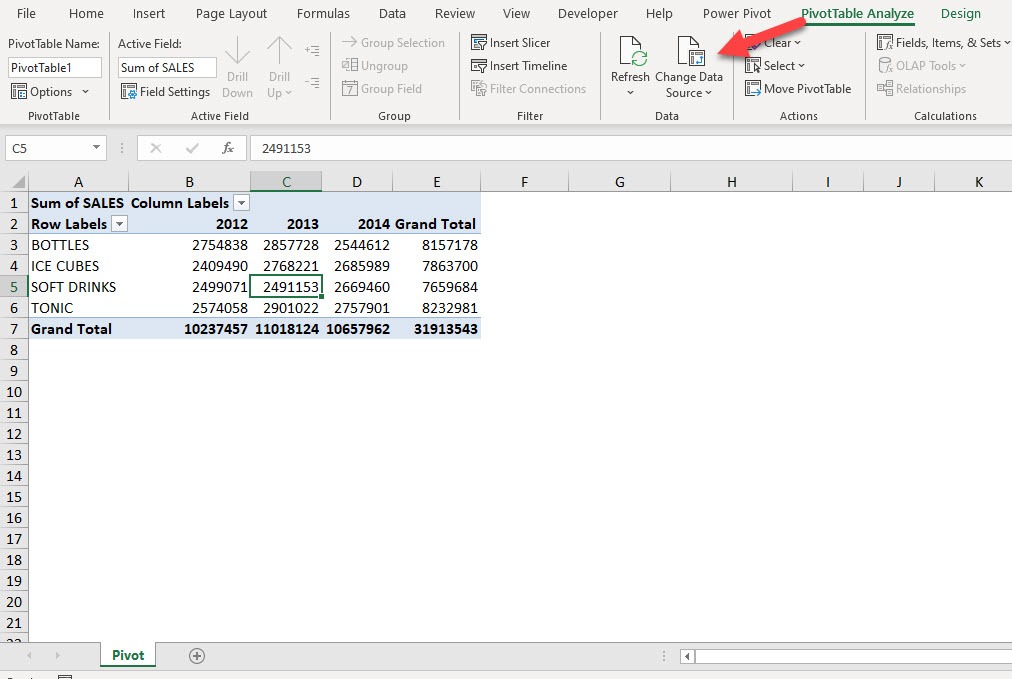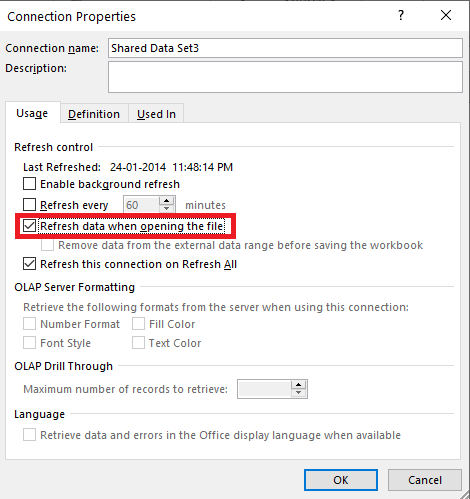The cool thing with Pivot Tables is you can use a data source that is in a different workbook. The external data source could be stored in a shared drive in your company server that your team uses, or it could be in a different location stored in your computer. Imagine this external data source will be updated frequently and we would not know when it got updated. So, how would we ensure that our Pivot Table is refreshed and shows updated data?
In this article, I will show you a couple of methods on how to refresh the external data source in the Pivot Table.
Key Takeaways:
- Pivot Tables can use external data sources stored on your computer or a shared drive.
- Refreshing is essential to ensure your Pivot Table always shows the latest data.
- Three main refresh methods: manual refresh, refresh on file open, and refresh at regular intervals.
- Always check your connection properties to confirm how your Pivot Table is linked.
- Best practices like saving before refreshing and keeping file paths consistent help avoid errors.
Before you proceed, don’t forget to download this workbook and follow along:
Table of Contents
External Data Source in Pivot Table
Why Refreshing External Data Matters
When you connect a Pivot Table to an external data source, you’re essentially creating a live link to another file. This means that your Pivot Table does not store all the values—it pulls them whenever you refresh it. If the source data changes (new sales, updated numbers, corrections), your Pivot Table won’t automatically know unless you tell Excel to update the connection.
Without refreshing:
- You might end up making decisions with outdated numbers.
- Your reports may not align with the current dataset.
- Collaboration gets messy when multiple people update the source but no one refreshes the Pivot Table.
Refreshing ensures your reports and insights are always based on the latest available data.
Check whether Pivot Table has External Data Source or Not
Let us check out our Pivot Table if it does really have an External Data Source.
Go to PivotTable Analyze > Data > Change Data Source
You can see that it is using an external data source. Click OK.
Top 3 methods to Refresh External Data Source
Manual Refresh
To update this, the good old-fashioned manual way, right-click on the Pivot Table and select Refresh
That’s it—Excel will fetch the latest data from the external source. While this method is easy, the downside is you need to remember to do it every time. Forgetting even once could lead to outdated reports.
Refresh when opening the file
There is another way to ensure your Pivot Table is updated.
STEP 1: Go to PivotTable Analyze > Data > Change Data Source > Connection Properties
STEP 2: Select the checkbox – Refresh data when opening the file.
Now, every time you open the file, Excel automatically refreshes the Pivot Table. This is a great way to ensure you never forget to refresh, especially if the file is part of your daily reporting routine.
Refresh at regular intervals
STEP 1: Go to PivotTable Analyze > Data > Change Data Source > Connection Properties
STEP 2: Select the checkbox – Refresh every X minutes.
This ensures that your Pivot Table stays in sync with the source without you lifting a finger.
Best Practices When Refreshing External Data
Refreshing sounds easy enough, but a few smart practices can save you headaches:
- Save Before Refreshing: If something goes wrong (like the source file being moved), you don’t want to lose unsaved work.
- Keep File Paths Consistent: If the external file is renamed or moved, the connection breaks. Use a shared server or a consistent folder structure.
- Use Descriptive File Names: Helps avoid confusion when multiple external data sources are used.
- Check Performance Impact: Large datasets can cause lag during refresh. Consider filtering or reducing unnecessary data in the source.
- Test Intervals Wisely: Setting refresh every 1 minute may crash your system. Pick intervals that balance accuracy and performance.
FAQs
How do I know if my Pivot Table is connected to an external data source?
You can check this by going to PivotTable Analyze > Data > Change Data Source. If the location points to another workbook or file outside your current one, then it is using an external data source. This could be a file stored on your computer or a shared drive in your company’s server. External data sources allow your Pivot Table to pull fresh data without storing everything inside your workbook. However, it also means you need to refresh regularly to keep the Pivot Table updated.
Why is it important to refresh my Pivot Table when using an external data source?
When your Pivot Table relies on external data, it doesn’t automatically update itself when the source changes. If you don’t refresh, your reports might show outdated numbers, leading to incorrect analysis or decisions. For example, sales figures could be updated in the source file, but your Pivot Table won’t show them until refreshed. Refreshing ensures your insights match the current dataset. Essentially, refreshing is what keeps your Pivot Table alive and reliable.
What are the different ways to refresh an external data source in Excel?
There are three main methods: manual refresh, refresh on file open, and refresh at regular intervals. Manual refresh requires you to right-click the Pivot Table and choose Refresh, which is simple but easy to forget. Refresh on file open automatically updates the data every time you open the workbook. Refresh at regular intervals tells Excel to update the data after a set number of minutes, which is useful for constantly changing datasets. Choosing the right method depends on how frequently your data source updates and how you use your Pivot Table.
What should I do if my Pivot Table refresh is very slow?
A slow refresh often happens when the external data source is very large or stored in a shared network drive. One way to improve performance is to filter or reduce unnecessary data in the source before connecting it. You can also use Power Query to pre-clean and load only the required data into your Pivot Table. Keeping your workbook size small helps Excel process refreshes faster. Lastly, avoid setting refresh intervals too frequently, as this can overload both your system and the network connection.
What common problems might I face when refreshing external data and how can I fix them?
The most common issue is when Excel shows an error because the source file was moved, renamed, or deleted. To fix this, update the link in Change Data Source to point to the correct file. Another issue is that updated changes in the source don’t appear—this usually means the source file wasn’t saved before refreshing. Sometimes, links break when sharing workbooks with others if they don’t have access to the file path. The best practice is to use a consistent, shared location and always save changes in the external file before refreshing.

Bryan
Bryan Hong is an IT Software Developer for more than 10 years and has the following certifications: Microsoft Certified Professional Developer (MCPD): Web Developer, Microsoft Certified Technology Specialist (MCTS): Windows Applications, Microsoft Certified Systems Engineer (MCSE) and Microsoft Certified Systems Administrator (MCSA).
He is also an Amazon #1 bestselling author of 4 Microsoft Excel books and a teacher of Microsoft Excel & Office at the MyExecelOnline Academy Online Course.












